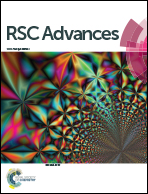Experimental and theoretical interpretation of the magnetic behavior of two Dy(iii) single-ion magnets constructed through β-diketonate ligands with different substituent groups (–Cl/–OCH3)†
Abstract
Two Dy(III) single-ion magnets, formulated as [Dy(Phen)(Cl-tcpb)3] (Cl-1) and [Dy(Phen)(CH3O-tmpd)3] (CH3O-2) were obtained through β-diketonate ligands (Cl-tcpb = 1-(4-chlorophenyl)-4,4,4-trifluoro-1,3-butanedione and CH3O-tmpd = 4,4,4-trifluoro-1-(4-methoxyphenyl)-1,3-butanedione) with different substituent groups (–Cl/–OCH3) and auxiliary ligand, 1,10-phenanthroline (Phen). The Dy(III) ions in Cl-1 and CH3O-2 are eight-coordinate, with an approximately square antiprismatic (SAP, D4d) and trigonal dodecahedron (D2d) N2O6 coordination environment, respectively, in the first coordination sphere. Under zero direct-current (dc) field, magnetic investigations demonstrate that both Cl-1 and CH3O-2 display dynamic magnetic relaxation of single-molecule magnet (SMM) behavior with different effective barriers (Ueff) of 105.4 cm−1 (151.1 K) for Cl-1 and 132.5 cm−1 (190.7 K) for CH3O-2, respectively. As noted, compound CH3O-2 possesses a higher effective barrier than Cl-1. From ab initio calculations, the energies of the first excited state (KD1) are indeed close to the experimental Ueff as 126.7 cm−1 vs. 105.4 cm−1 for Cl-1 and 152.8 cm−1 vs. 132.5 cm−1 for CH3O-2. The order of the calculated energies of KD1 is same as that of the experimental Ueff. The superior SIM properties of CH3O-2 could have originated from the larger axial electrostatic potential (ESP(ax)) felt by the central Dy(III) ion when compared with Cl-1. The larger ESP(ax) of CH3O-2 arises from synergic effects of the more negative charge and shorter Dy–O distances of the axial O atoms of the first sphere. These charges and distances could be influenced by functional groups outside the first sphere, e.g., –Cl and –OCH3.



 Please wait while we load your content...
Please wait while we load your content...